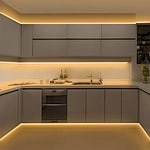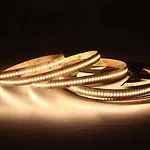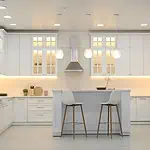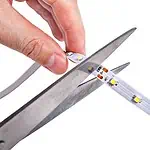Are you tired of frequent light replacement and the growing electricity bills using the old T12 fluorescent fixture? Upgrade it with T8 LED tube lights today!
Due to having the same G13 bi-pin base, it is possible to use T8 LED tube lights in T12 fixtures. You can physically replace them as long as you keep the length constant. To ensure the T8 LED tube light is electrically compatible with the T12 fixture, check on the ballast type. Depending on the T8 LED tube and its compatibility, you may need to bypass the wiring of the old fixture, remove the ballast completely, or replace it with a compatible one.
Upgrading to a T8 LED tube light will bring you many benefits. So, if you plan to replace your old T12 fixtures, you are on the right track. Keep reading to learn how to use T8 LED tube light in T12 fixtures-
What Are T8 And T12 Tube Lights?
T8 and T12 tube lights determine the diameter of the tube light. The letter ‘T’ indicates tube light, whereas the digits after the letter determine their diameter. T8 tube lights have a diameter of 8-eighths of an inch, or 1 inch. On the other hand, in T12 tube lights, the tube diameter is 12-eighths of an inch or 1.5 inches. T12 lights mostly come as fluorescent tube lights, but an LED option is also available. However, T8 bulbs are popular as both fluorescent and LED tube lights.
Both T8 and T12 tube lights are available in different sizes/lengths. The most common lengths for T8 lights are 4ft; 2 ft, 3ft, 5ft, and 8ft are also available. On the other hand, standard lengths for T12 bulbs are 4ft, 6ft, and 8ft. Besides, both the tube lights use a G13 bi-pin base. That is, the distance between the pins is 13mm. So, except for the diameter, other properties like socket sizes, lengths, and distance between pins of T8 and T12 tube lights are the same.
| Criteria | T8 | T12 |
| Diameter | 8-eighths of an inch, or 1 inch | 12-eighths of an inch or 1.5 inch |
| Technology | Fluorescent & LED | Fluorescent & LED |
| Common Lengths | 2ft, 3ft, 4ft, 5ft, and 8ft | 4ft, 6ft, and 8ft |
| Base | G13 bi-pin base | G13 bi-pin base |
| Distance between pin | 13mm | 13mm |
Is It Possible To Use T8 LED Tube Lights In T12 Fixtures?
T8 LED tube lights use LED technology. That is, they have light-emitting diodes that produce light. In contrast, T12 fixtures are traditional fluorescent lights that use gas to proceed with mercury. To check whether it is possible to use a T8 LED tube light in a T12 fixture, you need to match physical and electrical compatibility.
Physical Compatibility
Both the T8 LED tube light and T12 fixture have a G13 bi-pin base. So, the distance between the pins is 13mm for both. That is, a T8 LED tube light will fit in the socket of the T12 fixture. For physical compatibility, you only need to consider the tube light’s length. If the existing T12 fixture is 8ft, you can’t replace it with a 4ft T8 LED tube light. Therefore, if the length of the T8 LED tube light and T12 fixture is the same, they are physically interchangeable.
Electrical Compatibility
Though you can easily fit a T8 LED tube light into a T12 fixture, electrical compatibility will decide whether you can replace them. For electrical compatibility, you need to consider ballast type. The modern T8 LED tube lights are direct-wire compatible. That is, they directly connect to the line voltage without requiring any ballast. However, some may have electronic ballast integrated within the tube. In contrast, the T12 fixture has magnetic ballast, which is designed for fluorescent T12 tube lights. Most of the T8 LED lights are incompatible with this ballast design. And using a mismatched ballast can cause safety hazards and damage the fixture. Does it mean you can’t use a T8 LED tube light in a T12 fixture? Yes, you can, but how?
Depending on the type of T8 LED tube light, there are two ways to use the LED tube light on a T12 fixture. If your T8 LED tube light is direct-wire compatible, you will need to bypass the ballast. And if it’s a non-direct-wire T8 LED tube light, you will need to replace the ballast. Here are details of how you can achieve electrical compatibility by using T8 LED tube lights in T12 fixtures:
- Direct-wire Compatible T8 LED Tube Light:
If the T12 fixture allows rewiring or ballast removal, you can bypass the existing T12 ballast with direct-wire compatible T8 LED tube lights. For this, you will need to disconnect the ballast wiring and connect the T8 LED tube light directly to the line voltage. Such replacement is easy, but in some cases, you may need to modify the fixture’s wiring. To do this, you will need a professional electrician.
- Non-Direct-Wire T8 LED Tube Light:
For non-direct-wire T8 LED tube lights, you will need to replace the existing T12 ballast with a compatible T8 ballast. For this, you need to find a suitable T8 ballast that will fit within the available space in the fixture. This may vary for different configurations of the T8 LED bulb; it might be compatible with full ballast replacement and ballast bypass (single or double-ended). All you need to do is get the ideal ballast type to replace the T12 ballast. However, some non-direct-wire T8 LEDs have electronic ballasts integrated within the tube. These eliminate the need for replacing the fixture’s ballast but might have specific wiring requirements based on the model.
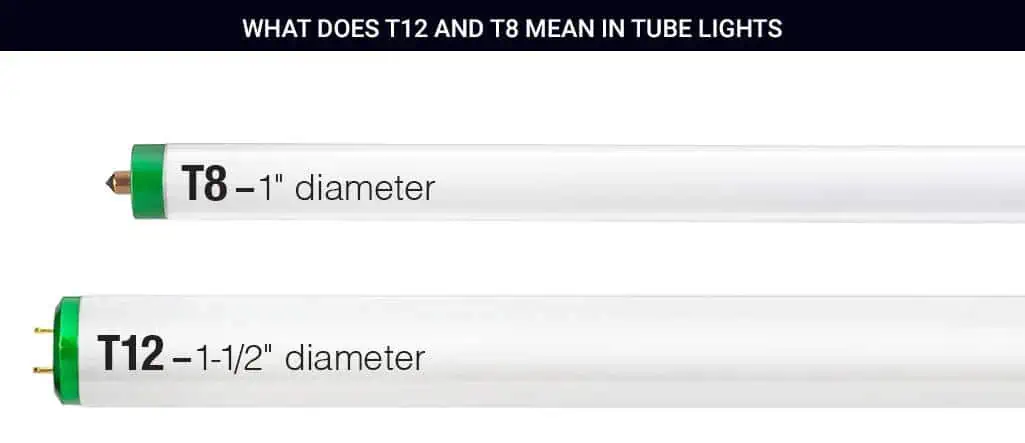
Why Use T8 LED Tube Lights In T12 Fixture? – Know The Benefits
Before replacing your T12 fixture with an LED T8 tube light, consider whether it is really needed. LED T8 tube lights will bring you many additional benefits apart from reducing electricity bills. Here is why you should use T8 LED tube light-
Energy Efficiency & Lower Operating Costs
LED T8 tube lights are 70% more energy efficient than T12 fluorescent fixtures. That is, replacing your old T12 fixture with an LED T8 light will consume less energy. This will eventually reduce your electricity bills. Thus, using T8 is cost-effective in the long run.
Longer Lifespan
LED technology is known for its longer lifespan. A T8 LED tube light can last for about 50,000 to 100,000 hours. Meanwhile, the lifespan of a traditional T12 fixture is roughly 18,000-20,000 hours on average. So, replacing your old T12 fixture with a T8 LED tube light will save you from the hassle of frequent replacement.
Better Color Rendering
Color Rendering Index or CRI terms the color accuracy of the fixture compared to that of natural lighting. T8 LED tube lights typically have CRI values of 80-90 or higher. On the other hand, T12 fluorescent lights usually have CRI ranging from 60 to 70. So, the lighting from the T8 LED fixture gives more color accuracy than the T12 fluorescent fixture. This means colors appear more vivid and true to life under T8 LED lighting. To learn more about the Color Rendering Index, check this- What is CRI?
Wide Range Of Color Temperature
T8 LED tube lights are available in a wide range of color temperatures ranging from 2700K to 6500K. So, with T8 LED tube lights, you can have both warm and cool lighting options. In contrast, the fluorescent T12 fixture has a limited color temperature option. Most of them come with higher CCT that gives off cool white lighting. So, a T12 fixture might not be an ideal choice if you need more stature light. To decide on the color temperature of your T8 LED tube light, read this guide- Warm Light vs. Cool Light: Which Is Best and Why?
Improved Light Quality
T12 fluorescent tube lights lose light output over time. In contrast, T8 LEDs provide consistent brightness for a longer time. Besides, they offer better color rendering compared to T12 tubes. Thus, using T8 TLD lights, you will get sharper, more vibrant colors and better overall light output.
Environmental Benefits
T12 fixtures use fluorescent technology. So, it contains gas inside the tube and is processed with mercury, which is harmful to the environment. In contrast, T8 LED tube lights don’t have any toxic elements. Besides this, LED T8 tube light reduces energy consumption and contributes little to carbon footprints. Thus, replacing T12 fluorescent tube lights with LED T8 will reduce greenhouse gas emissions.
Reduced Heat Emission
LED T8 tube lights convert 80% of energy to light; only 20% of the remaining energy is converted to heat. Compared to the T8 LED tube light, the T12 fluorescent fixture goes through more energy loss. That is, a more significant portion of energy is converted to heat. So, replacing T12 fixtures with T8 LED tube lights reduces heat emission.
Instant Start
T12 fixtures take some time to reach their full brightness. In these fluorescent light fixtures, electricity passes the inserted gas inside the tube that produces light. So, this takes a bit of time to reach maximum brightness. In contrast, LED T8 bulbs instantly glow as you switch them on.
Reduced Maintenance
The extended lifespan of T8 LED tube lights reduces the maintenance of lighting. You don’t need to replace them regularly. But you will need to replace the T12 fixture frequently as they have a lower lifespan. So, T8 LED tube lights will save you time and maintenance costs.
Things To Consider While Using T8 LED Tube Lights In T12 Fixture
T8 LED tube lights and T12 fixtures have the same G13 bi-pin base socket. So, you need not worry about socket compatibility when replacing your existing T12 bulb with an LED T8 tube light. But there are some factors that are essential to count; these are as follows-
Ballast Type
You must consider the ballast type when purchasing T8 LED tube lights to use in a T12 fixture. They are available in two variants- ballast bypass and ballast-compatible LED tubes. Buying the ballast bypass variants requires the fixture to bypass the blast and connect the T8 LED tube light to the main power. If it’s your first time, you might find this kind of wiring critical. But to save from this, the best option is to choose a T8 LED tube light that can work with the existing ballast of the T12 fixture.
Lamp Length and Diameter
If the length of the LED T8 tube light you purchased is longer or shorter than the existing T12 fixture, it won’t fit the ending caps of the existing base. This is why you need to consider the length of the tube light when replacing it. For example, if your T12 fixture is 4ft, purchase the same length when replacing it with a T8 LED tube light. This will remove the length incompatibility issues. Thus, you can easily fit the new light in the base. However, with the diameter, there is nothing to be concerned about. This is because, though the T8 LED bulb and T12 fixture have differences in diameter, both have G13 bi-pin base sockets. So, as long as you keep the length consistent, you will not face any physical compatibility issues.
Voltage Compatibility
Both T8 LED tube lights and T12 fixtures work with the main power voltage supply. However, some LED T8 tube lights might still require low voltage. So, before purchasing the fixture, review the specifications and check the voltage ratings.
Color Temperature
If you want to change the cool lighting of the existing T12 fixture, the T8 LED tube light offers you a wide range of options. For a cozy and relaxing ambiance in your room, choose a warm color T8 LED that ranges from 2500K to 3500K. The lower the CCT, the warmer the lighting output. Besides, you will also get cool color temperature choices in LED T8 tube lights. Choose lights ranging from 4000K to 6500K. If you want daylight effort, go for higher CCT; 6500K gives the perfect daylighting effect.
Initial Cost vs. Long-Term Savings
LED lights use more advanced technology than fluorescent fixtures. This makes T8 LED tube light more expensive than T12 fixtures that use fluorescent technology. The initial cost of choosing the LED tube light will be high, but it will surely be cost-effective in the long run. Firstly, the T8 LED tube light is more energy efficient than the T12 fixture. This is how it will save your electricity bills. Again, they run much longer than T12 fixtures; you won’t need to replace them frequently. Here, it will save your maintenance costs. But the fact to consider is the warranty. Though LED T8 tube lights have a long lifespan, you should buy fixtures with greater warranty time. So, if your fixture faces any type of issue by this time, you can make a claim against it. However, purchasing branded tube lights from a reliable source is best to ensure you get the warranty facility.
Safety Precautions
You must follow the safety precautions when using the T8 LED tube light in T12 fixtures. Firstly, turn off the light and let it cool down. Once it is cool, you can touch it to uninstall it. It is better not to touch them with bare hands, though there is no chance of electric shock as you have already turned off the power. But you must make sure your hand is not wet. After removing the fixture, gently place it in a safe place away from kids. Next, you can install the T8 LED tube light. However, if rewiring is required, you may need assistance from a professional electrician.
Safe Disposal Of The Old Fixture
As T12 fixtures contain mercury, you should take additional care during disposal. Mercury harms the environment, so you can’t dispose of it anywhere. Contact a local hazardous waste program or look for an electronics recycling facility for safe disposal. If your fixture is broken, don’t throw it in the bin. The broken pieces of glass tube can harm the animals. Read this to learn more about safe disposal: How do you dispose of LED strip lights?
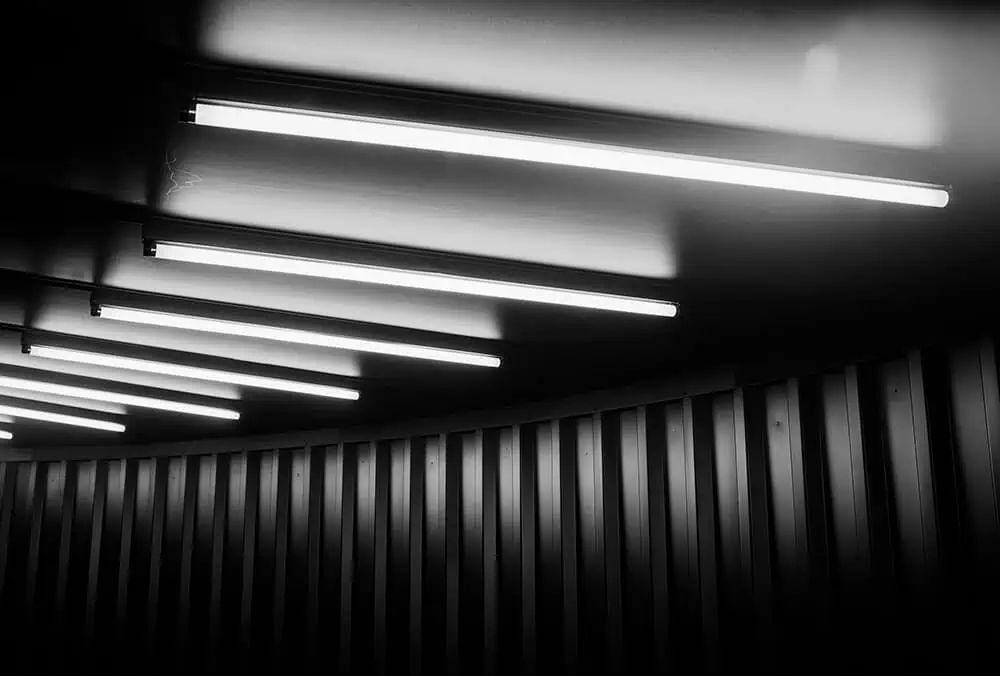
How To Use T8 LED Tube Lights In T12 Fixtures? – Installation Guide
You need to remove the T12 fixture, adjust the ballasts, and install the T8 LED tube light. Here is the step-by-step procedure-
Step 1: Collect The Required Materials
Here is what you need to gather before starting the installation process:
- LED tube lights (appropriate size and type)
- Screwdriver
- Wire nuts
- Wire strippers
- Voltage tester
- Ladder or step stool
- Safety gloves and goggles
Step 2: Remove Existing T12 Tubes
Turn off the power to remove the T12 fixture. Wait for a few minutes to cool down the fixture. Now, carefully unscrew the end caps of the fixture and gently remove the old T12 tubes.
Step 3: Check Ballast Type
Fluorescent light fixtures usually use a magnetic or electronic ballast. If you are unsure of the type of ballast in your light fitting, you might try to find a flicker in the tube light or listen for a buzzing sound. If you can see or hear it, it might be magnetic ballast. Additionally, you may use your smartphone to snap a photo of the tube while it’s turned on. If black bars or stripes are running across the screen, the lights are magnetically ballasted. However, there is a good probability that electrical ballast is causing a clear image. After checking the blast type, you can decide on the installation method.
Step 4: Fix The Ballast To Match The T8 LED Tube Light
If the fitting has an electronic ballast, remove it to place the T8 LED tube. Unplug the cables from the ballast unit and take out the device. Then, join the free wires to the circuit. Ensure all the connections are safe after this point.
But if it’s magnetic ballast, depending on the particular fixture and tube type, you might need to remove or avoid the magnetic ballast entirely. Some LED tubes include an LED starter, making your installation much easier. It is a small device that looks like a cylindrical 9-volt battery. It might also work just by removing the starter. So, how you will handle the blast and wiring depends on the LED T8 tube light type. In this case, the safest option is to go to a certified electrician who will handle the wiring.
Step 5: Connect The New LED Tube
Once your ballast fitting is done, you can install the new T8 LED tube light. Every tube light has a neutral and live point. Take time to detect the two ends and connect them accordingly. Make sure the fitting wires match the neutral and live points. Read the guidelines that come with the tube light packaging. A wrong installation can cause a short circuit, so be careful.
Step 6: Turn On The Power
Turn on the power, and the light will glow if the wirings are correct. If you find any buzzing sound or flickering issues, check if all the above steps are done correctly. Yet, if you can identify the problem, go to a professional electrician. However, for a more extensive installation guide, read this- A Comprehensive Guide To Choosing And Installing LED Tube Lights.
Once the T8 LED tube light is installed, you should dispose of the old T12 fixture appropriately. Follow the basic guidelines for disposing of fluorescent fixtures.
Troubleshooting Common Issues While Upgrading T12 to T8
You might face several issues while upgrading your old T12 fixture to T8 LED lighting. Here is how to fix the most common ones-
- Flickering Lights
Your upgraded T8 LED tube light may face flickering issues due to ballast incompatibility. For instance, if you have bypassed the magnetic ballast for direct wiring, voltage fluctuations might lead to flickering. Besides, this can also be caused due to an internal default of the tube light or loose wiring. To solve this, contact an electrician or replace the fixture with a new one.
- Buzzing or Noisy Ballasts
Though T8 LED tube lights operate silently, a buzzing noise can indicate ballast incompatibility or aging of the electronic ballast. You will face these issues if the ballast has failed or is too old; it will cause humming or buzzing sounds. Replace the blast with a new one for optimal performance. You can also try a different ballast compatible with the LED T8 tube light.
- Hot or Overheating Fixtures
If your T8 tube light is not seated correctly in the sockets, it can lead to overheating. This occurs due to poor thermal contact. If you purchase low-quality tube lights, these problems may arise. So, always purchase high-quality lights and also ensure the installation is secure. You should add small ventilation holes or replace them with a fixture designed for LED use.
- Inconsistent or Uneven Illumination
If you have a dimmable T8 tube light, it may show uneven lighting due to using an incompatible dimmer switch. Besides, loose connections can disrupt the power flow, causing uneven brightness. Some tube lights may also have internal manufacturing defects, resulting in inconsistent lighting. So, use a compatible dimming switch and tighten all the connections. If this doesn’t solve the issue, replace it with a new one.
- Issues with Non-Shunted Sockets
Using an incompatible socket can cause performance issues with the tube light. T8 LED tubes may require either shunted or non-shunted tombstone sockets. So, if you have non-shunted sockets, you need to use non-shunted LED tube lights, and vice versa.
- Electromagnetic Interference (EMI)
Some T8 LED tubes may generate electromagnetic interference that affects nearby electronic devices. For instance, you may find unusual sounds during phone calls due to EMI. If you experience interference issues, search for LED tube lights with built-in filters to reduce EMI. You can also consult with the manufacturer for recommended solutions.
Besides the following, your LED T8 light may go through a few more issues. But to avoid those, make sure you have a correct installation and the fixture is of good quality. Apart from this, also check the voltage and current flow. If you can ensure these facts, you won’t face any trouble while upgrading your T12 fixture to T8 LED tube light. For more information, read this article- Advantages and Disadvantages of LED Lighting.
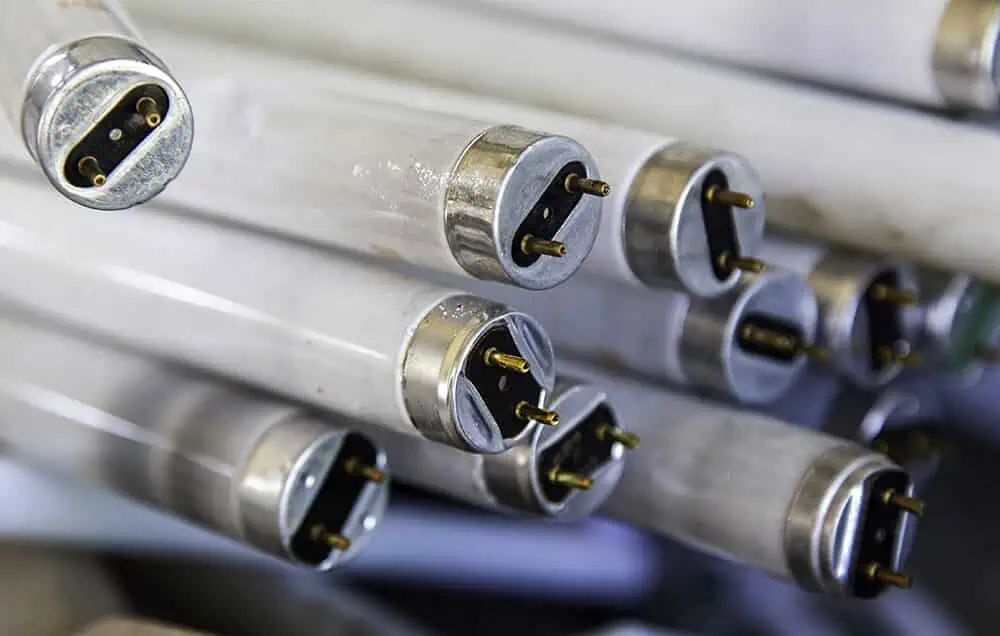
FAQs
You can use a T8 LED bulb in a fluorescent fixture only if it is physically and electrically compatible. For physical compatibility, keep the length of the bulb constant. For electrical compatibility, check out the ballast types and voltage.
T8 bulbs generally produce more lumens per watt than T12 bulbs. This means they provide brighter light using less energy. For example, a 15-watt T8 LED bulb can produce around 1800 lumens. In contrast, a 40-watt T12 fluorescent might only reach 2000 lumens. Thus, T8 LED lights are more energy efficient than T12 lights.
T12 lamps use fluorescent technology that contains mercury, which is harmful to the environment. Besides, advanced LED technology arrived that is highly energy efficient compared to T12 lamps. These facts caused the discontinuation of traditional T12 lamps.
Whether you need to remove the ballast to use an LED bulb in a fluorescent light depends on the ballast type. If it has an electronic ballast, you can install compatible LED bulbs directly without removing it. However, using LEDs with magnetic ballasts can be tricky. For this, you will either have to bypass wiring or purchase LED tube lights specially designed for magnetic ballasts.
Whether your T8 LEDs will work with ballast or not depends on the type of fixture you are using. Though they can work directly with electronic ballasts, you must bring modifications to run them with magnetic ballasts.
A standard T12 fluorescent fixture has a lumen output of around 2500 lumens. This is much lower than LED tube lights.
A T12 uses approximately 60 lumens per watt. So, a two-lamp fixture typically uses 90 watts, whereas a four-lamp variant uses 160–170 watts, depending on the ballast.
The main difference between T8 LED and T8 fluorescent bulbs is their technology. The T8 LED fixture uses light-emitting diodes to produce lighting. They are energy efficient because they consume less energy to produce greater light output. In contrast, T8 fluorescent bulbs contain mercury, which is unsafe for the environment. And this is also energy efficient. This makes T8 LEDs better than T8 fluorescent bulbs.
The Bottom Line
From the above discussion, it is clear that you can use T8 tube lights in T12 fixtures. Now, is it a good decision to take this hassle? Of course, it is. Switching your T12 fluorescent light with a T8 LED tube light will bring you the added benefits of LED technology. They last longer and are highly energy efficient. Thus, it will save your electricity bills. Though LED T8 lights are costly for the initial period, in the long run, they are cost-effective.
The main physical difference between T12 and T8 light is in their diameter. But while upgrading the T12 fixture, there is nothing to be concerned about as they have the same base. All you need to make sure is the tube length is kept constant. After ensuring this, the crucial factor to consider next is ballast compatibility. Detect if the LED T8 tube light that you purchased is a direct-wire compatible or a non-direct-wire one. You must rewire or remove the blast if it’s a direct wire T8 LED light. And for a non-direct-wire T8 light, you will need to use a compatible ballast. While doing this, make sure the connections are correct and secure. The best option is to contact a professional electrician if you find wiring difficult.
